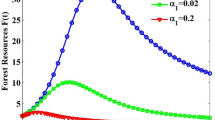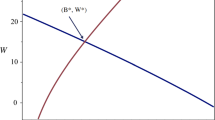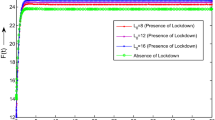Abstract
A nonlinear mathematical model is designed and analysed to investigate the impact of forest, non-forest-based industries and their pollutants on forest assets and wildlife population in the forest territory. The pollution from forest and non-forest-based industries is major cause for the depletion of forest resources and wildlife population. In the modelling process, it is assumed that pollutants emitted by both types of industries abate the growth rate of forest resources and wildlife population. However, the forest assets are being depleted by forest-based industries directly. Whether excessive expansion of non-forest-based industries and their pollutants are also major responsible for the loss of ecology between forest resources and wildlife population. The model is expressed in the form of nonlinear dynamical systems considering as different variables and equations. The model is analysed by both ways of method like qualitative and quantitative analysis. Qualitative analysis deduces important results and properties of the model like stability region, finding of equilibriums and their stabilities. However, the model is also analysed by quantitatively to obtained numerical results. It is also deduced that the pollutants which are emitted by non-forest-based industries are more vulnerable to ecology.








Similar content being viewed by others
References
Agarwal M, Devi S (2012) A resource-dependent competition model: effects of population pressure augmented industrialization. Int J Model Simul Sci Comput 3(2):1–22. https://doi.org/10.1142/S1793962312500031
Agarwal M, Pathak R (2015) Conservation of forestry biomass and wildlife population: a mathematical model. Asian J Math Comput Res 4(1):1–15
Agarwal M, Fatima T, Freedman HI (2010) Depletion of forestry resource biomass due to industrialization pressure: a ratio-dependent mathematical model. J Biol Dyn 4(4):381–396. https://doi.org/10.1080/17513750903326639
Agarwal A, Cashore B, Hardin R, Shepherd G, Benson C, Miller D (2013) Economic contribution of forests, United Nations forum on forests. https://www.un.org/esa/forests/wp-content/uploads/2015/12/EcoContrForests.pdf
Agarwal M and Bhadauria AS (2014) Modeling the effect of technology on theconservation of forestry resource biomass depleted by industrialization, population pressure and toxicants. Ganita 63(2012)1–31. http://bharataganitaparisad.com
Chaudhary M, Dhar J, Sahu GP (2013) Mathematical model of depletion of forestry resource: effect of synthetic based industries. Int J Biol Sci 7(4):788–792
Chaudhary M, Dhar J (2013) Forestry biomass conservation with synthetic industry: a mathematical model. 2013 Nirma University International Conference on Engineering, NUICONE 2013, 1–5. https://doi.org/10.1109/NUiCONE.2013.6780205
Costanza R, Groot RD, Sutton P, Ploeg SVD, Anderson SJ, Kubiszewski I, Stephen F, Turner RK (2014) Changes in the global value of ecosystem services. Glob Environ Chang 26:152–158. https://doi.org/10.1016/j.gloenvcha.2014.04.002
Dubey B, Narayanan AS (2010) Modelling effects of industrialization, population and pollution on a renewable resource. Nonlinear Anal Real World Appl 11(4):2833–2848. https://doi.org/10.1016/j.nonrwa.2009.10.007
Dubey B, Upadhyay RK, Hussain J (2003) Effects of industrialization and pollution on resource biomass: a mathematical model. Ecol Model 167(1–2):83–95. https://doi.org/10.1016/S0304-3800(03)00168-6
Dubey B, Sharma S, Sinha P, ShuklaJ B (2009) Modelling the depletion of forestry resources by population and population pressure augmented industrialization. Appl Math Model 33(7):3002–3014. https://doi.org/10.1016/j.apm.2008.10.028
Heiskanen A, Hurmekoski E, Toppinen A, Nayh A (2022) Exploring the unknowns—state of the art in qualitative forest-based sector foresight research. Forest Policy Econ 135:102643. https://doi.org/10.1016/j.forpol.2021.102643
Kaur RP (2019) Impact of industry and export on the biomass resources. Int J Adv Sci Technol 28(9):433–449
Kaur RP (2020) Impact of Industry on the Forest Resources, Journal of Physics: Conference Series 1531, 012049 IOP Publishing. https://doi.org/10.1088/1742-6596/1531/1/012049
Kumar P (2020) Hopf-bifurcation induced by delay parameter in depletion of forest biomass due to wood-based industries. Eur J Mol Clin Med 7(7):3646–3652
Lata K, Misra AK, Shukla JB (2014) Effects of population and population pressure on forest resources and their conservation: a modeling study. Environ Dev Sustain 16:361–374. https://doi.org/10.1007/s10668-013-9481-x
Lata K, Dubey B, Misra AK (2016) Modeling the effects of wood and non-wood based industries on forestry resources. Nat Resour Model 29(4):559–580. https://doi.org/10.1111/nrm.12111
Lata K, Misra AK, Shukla JB (2018) Modeling the effect of deforestation caused by human population pressure on wildlife species. Nonlinear Anal 23(3):303–320. https://doi.org/10.15388/NA.2018.3.2
Maystruk V, Abdella K (2011) Modelling the effects of pollution on a population and a resource in a polluted environment. ISRN Appl Math. https://doi.org/10.5402/2011/643985
Misra AK, Lata K, Shukla JB (2014) A mathematical model for the depletion of forestry resources due to population and population pressure augmented industrialization. Int J Model 5(1):1350022-1–1350022-16
Pathak R (2018) Depletion of forest resources and wildlife population with habitat complexity: a mathematical model. Open J Ecol 08(11):579–589. https://doi.org/10.4236/oje.2018.811034
Shah NH, Satia MH, Yeolekar BM (2017) Optimum control for spread of pollutants through forest resources. Appl Math 08(05):607–620. https://doi.org/10.4236/am.2017.85047
Starka S, Freudenberger LB, Dietz T, Escobar N, Förster JJ, Henderson J, Laibache N, Börner J (2022) Sustainability implications of transformation pathways for the bioeconomy. Sustain Prod Consum 29:215–227. https://doi.org/10.1016/j.spc.2021.10.011
Timothy A, Oblade F, Dubey S (2014) Managing tourism as a source of revenue and foreign direct investment inflow in a developing country: the jordanian experience. Int J Acad Res Econ Manage Sci. https://doi.org/10.6007/IJAREMS/v3-i3/901
Author information
Authors and Affiliations
Corresponding author
Additional information
Publisher's Note
Springer Nature remains neutral with regard to jurisdictional claims in published maps and institutional affiliations.
Appendices
Appendix A
Following are the transformations that can be made:
with \(x_{1} ,\,x_{2} ,\,x_{3} ,\,x_{4} \,{\text{and}}\,x_{5}\) as minor perturbations around \(E_{3}\), the following positive definite function is considered:
where \(l_{1} ,\,l_{2} ,\,l_{3} \,{\text{and}}\,l_{4}\) are positive constants.
In Eq. (51), we get the derivative of \(V\) with respect to '\(t\)'.
If we choose
\(( - \varphi + l_{4} \theta \varphi W^{ * } )\) = 0, this gives \(l_{4} = \frac{1}{{\theta W^{ * } }}\).
\(( - \beta_{1} + l_{1} \pi_{1} \beta_{1} W^{ * } + l_{1} \pi_{2} I_{N}^{ * } F^{ * } )\) = 0, this gives \(l_{1} = \frac{{\beta_{1} }}{{\pi \beta_{1} W^{ * } + \pi_{2} I_{N}^{ * } F^{ * } }}\).
\((l_{1} \pi_{2} {F^{ * }}^{2} - l_{1} c_{1} I_{W}^{ * } - l_{2} c_{2} I_{N}^{ * } )\) = 0, this gives \(l_{2} = \frac{{\beta_{1} (\pi_{2} {F^{ * }}^{2} - c_{1} I_{W}^{ * } )}}{{c_{2} I_{N}^{ * } (\pi_{1} \beta_{1} I_{W}^{ * } + \pi_{2} F^{ * } I_{N}^{ * } )}}\).
With these, Eq. (53) can be written as
If we choose \(l_{3} = 1\), we have.
Now,\(\frac{dV}{{dt}}\) will be negative if.
-
(i)
\(( - \beta_{2} F^{ * } )^{2} < \frac{{l_{2} }}{4}(\frac{r}{L} + \beta_{2} I_{N}^{ * } )(c_{2} I_{W}^{ * } + \varphi_{2} )\)which can be written as
$$4c_{2} I_{N}^{ * } (\pi_{1} \beta_{1} I_{W}^{ * } + \pi_{2} F^{ * } I_{N}^{ * } )(\beta_{2} F^{ * } )^{2} < (\frac{r}{L} + \beta_{2} I_{N}^{ * } )(c_{2} I_{W}^{ * } + \varphi_{2} )\beta_{1} (\pi_{2} {F^{ * }}^{2} - c_{1} I_{W}^{ * } )(c_{2} I_{W}^{ * } + \varphi_{2} )$$ -
(ii)
\((\beta_{3} + l_{3} \theta_{3} P^{ * } )^{2} < \frac{{l_{3} }}{8}(\frac{r}{L} + \beta_{2} I_{N}^{ * } )(\theta_{3} F^{ * } + \mu_{0} - \pi \alpha_{1} W^{ * } )\)which can be written as
$$8(\beta_{3} + \theta_{3} P^{ * } )^{2} < (\frac{r}{L} + \beta_{2} I_{N}^{ * } )(\theta_{3} F^{ * } + \mu_{0} - \pi \alpha_{1} W^{ * } )$$ -
(iii)
\((l_{3} \theta_{1} )^{2} < \frac{{l_{1} l_{3} }}{4}(c_{1} I_{N}^{ * } + \varphi_{1} - \pi_{1} \beta_{1} F^{ * } )(\theta_{3} F^{ * } + \mu_{0} - \pi \alpha_{1} W^{ * } )\)which can be written as
$$4(\pi_{1} \beta_{1} I_{W}^{ * } + \pi_{2} F^{ * } I_{N}^{ * } )\theta_{1}^{2} < \beta_{1} (c_{1} I_{N}^{ * } + \varphi_{1} - \pi_{1} \beta_{1} F^{ * } )(\theta_{3} F^{ * } + \mu_{0} - \pi \alpha_{1} W^{ * } )$$ -
(iv)
\((l_{3} \theta_{2} )^{2} < \frac{{l_{2} l_{3} }}{8}(c_{2} I_{W}^{ * } + \varphi_{2} )(\theta_{3} F^{ * } + \mu_{0} - \pi \alpha_{1} W^{ * } )\)which can be written as
$$8(\pi_{1} \beta_{1} I_{W}^{ * } + \pi_{2} F^{ * } I_{N}^{ * } )c_{2} I_{N}^{ * } \theta_{2}^{2} < \beta_{1} (\pi_{2} {F^{ * }}^{2} - c_{1} I_{W}^{ * } )(c_{2} I_{W}^{ * } + \varphi_{2} )(\theta_{3} F^{ * } + \mu_{0} - \pi \alpha_{1} W^{ * } )$$ -
(v)
\((l_{3} \pi \alpha_{1} P^{ * } - l_{4} \alpha_{1} W^{ * } ) < \frac{{l_{3} l_{4} }}{4}(\theta_{3} F^{ * } + \mu_{0} - \pi \alpha_{1} W^{ * } )(\delta_{0} W^{ * } + \theta_{0} + \alpha_{1} P^{ * } - \theta \varphi F^{ * } )\)
which can be written as
$$4\theta W^{ * } (\pi \alpha_{1} P^{ * } - \frac{{\alpha_{1} }}{\theta })^{2} < (\theta_{3} F^{ * } + \mu_{0} - \pi \alpha_{1} W^{ * } )(\delta_{0} W^{ * } + \theta_{0} + \alpha_{1} P^{ * } - \theta \varphi F^{ * } ).$$
Appendix B
where \(m_{1} ,\,m_{2} ,\,m_{3} \,{\text{and}}\,m_{4}\) are positive constants.
In Eq. (55), we get the derivative of \(U\) with respect to '\(t\)'.
If we choose
\(( - \varphi + m_{4} \theta \varphi W^{ * } )\) = 0, this gives \(m_{4} = \frac{1}{{\theta W^{ * } }}\).
\(( - \beta_{1} + m_{1} \pi_{1} \beta_{1} W^{ * } + m_{1} \pi_{2} I_{N}^{ * } F^{ * } )\) = 0, this gives \(m_{1} = \frac{{\beta_{1} }}{{\pi \beta_{1} W^{ * } + \pi_{2} I_{N}^{ * } F^{ * } }}\).
\((m_{1} \pi_{2} {F^{ * }}^{2} - m_{1} c_{1} I_{W}^{ * } - m_{2} c_{2} I_{N}^{ * } )\) = 0, this gives \(m_{2} = \frac{{\beta_{1} (\pi_{2} {F^{ * }}^{2} - c_{1} I_{W}^{ * } )}}{{c_{2} I_{N}^{ * } (\pi_{1} \beta_{1} I_{W}^{ * } + \pi_{2} F^{ * } I_{N}^{ * } )}}\).
If we choose \(m_{3} = 1\), we have
Now,\(\frac{dU}{{dt}}\) will be negative if
-
(i)
\(( - \beta_{2} F^{ * } )^{2} < \frac{{m_{2} }}{4}(\frac{r}{L} + \beta_{2} I_{N}^{ * } )(c_{2} I_{W}^{ * } + \varphi_{2} )\)which can be written as
$$4c_{2} I_{N}^{ * } (\pi_{1} \beta_{1} I_{W}^{ * } + \pi_{2} F^{ * } I_{N}^{ * } )(\beta_{2} F^{ * } )^{2} < (\frac{r}{L} + \beta_{2} I_{N}^{ * } )(c_{2} I_{W}^{ * } + \varphi_{2} )\beta_{1} (\pi_{2} {F^{ * }}^{2} - c_{1} I_{W}^{ * } )(c_{2} I_{W}^{ * } + \varphi_{2} )$$ -
(ii)
\((\beta_{3} + m_{3} \theta_{3} P^{ * } )^{2} < \frac{{m_{3} }}{8}(\frac{r}{L} + \beta_{2} I_{N}^{ * } )(\theta_{3} F^{ * } + \mu_{0} - \pi \alpha_{1} W^{ * } )\)which can be written as
$$8(\beta_{3} + \theta_{3} P^{ * } )^{2} < (\frac{r}{L} + \beta_{2} I_{N}^{ * } )(\theta_{3} F^{ * } + \mu_{0} - \pi \alpha_{1} W^{ * } )$$ -
(iii)
\((m_{3} \theta_{1} )^{2} < \frac{{m_{1} m_{3} }}{4}(c_{1} I_{N}^{ * } + \varphi_{1} - \pi_{1} \beta_{1} F^{ * } )(\theta_{3} F^{ * } + \mu_{0} - \pi \alpha_{1} W^{ * } )\)which can be written as
$$4(\pi_{1} \beta_{1} I_{W}^{ * } + \pi_{2} F^{ * } I_{N}^{ * } )\theta_{1}^{2} < \beta_{1} (c_{1} I_{N}^{ * } + \varphi_{1} - \pi_{1} \beta_{1} F^{ * } )(\theta_{3} F^{ * } + \mu_{0} - \pi \alpha_{1} W^{ * } )$$ -
(iv)
\((m_{3} \theta_{2} )^{2} < \frac{{m_{2} m_{3} }}{8}(c_{2} I_{W}^{ * } + \varphi_{2} )(\theta_{3} F^{ * } + \mu_{0} - \pi \alpha_{1} W^{ * } )\)which can be written as
$$8(\pi_{1} \beta_{1} I_{W}^{ * } + \pi_{2} F^{ * } I_{N}^{ * } )c_{2} I_{N}^{ * } \theta_{2}^{2} < \beta_{1} (\pi_{2} {F^{ * }}^{2} - c_{1} I_{W}^{ * } )(c_{2} I_{W}^{ * } + \varphi_{2} )(\theta_{3} F^{ * } + \mu_{0} - \pi \alpha_{1} W^{ * } )$$ -
(v)
\((m_{3} \pi \alpha_{1} P^{ * } - m_{4} \alpha_{1} W^{ * } ) < \frac{{m_{3} m_{4} }}{4}(\theta_{3} F^{ * } + \mu_{0} - \pi \alpha_{1} W^{ * } )(\delta_{0} W^{ * } + \theta_{0} + \alpha_{1} P^{ * } - \theta \varphi F^{ * } )\)
which can be written as
$$4\theta W^{ * } (\pi \alpha_{1} P^{ * } - \frac{{\alpha_{1} }}{\theta })^{2} < (\theta_{3} F^{ * } + \mu_{0} - \pi \alpha_{1} W^{ * } )(\delta_{0} W^{ * } + \theta_{0} + \alpha_{1} P^{ * } - \theta \varphi F^{ * } ).$$
Rights and permissions
Springer Nature or its licensor (e.g. a society or other partner) holds exclusive rights to this article under a publishing agreement with the author(s) or other rightsholder(s); author self-archiving of the accepted manuscript version of this article is solely governed by the terms of such publishing agreement and applicable law.
About this article
Cite this article
Sinha, S.K., Pal, J. & Jyotsna, K. A dynamical study on the adverse effects of industrial activities in the forest and wildlife region through modelling. Model. Earth Syst. Environ. 9, 2053–2065 (2023). https://doi.org/10.1007/s40808-022-01581-6
Received:
Accepted:
Published:
Issue Date:
DOI: https://doi.org/10.1007/s40808-022-01581-6




